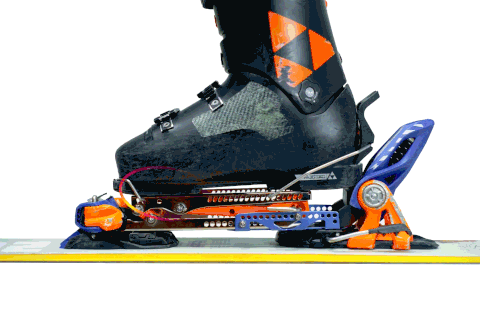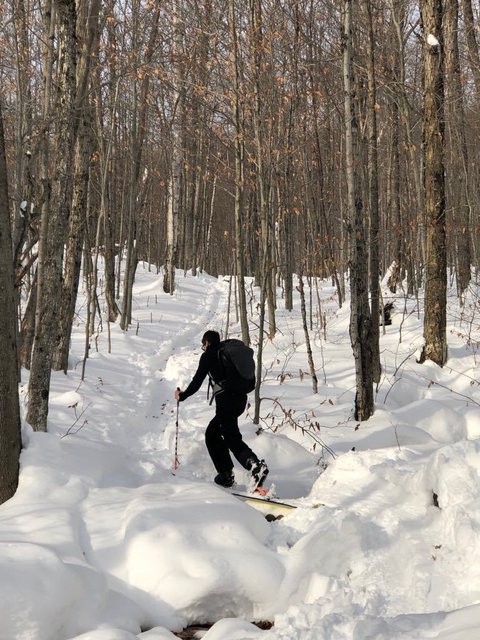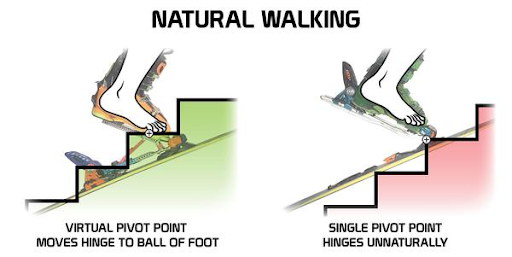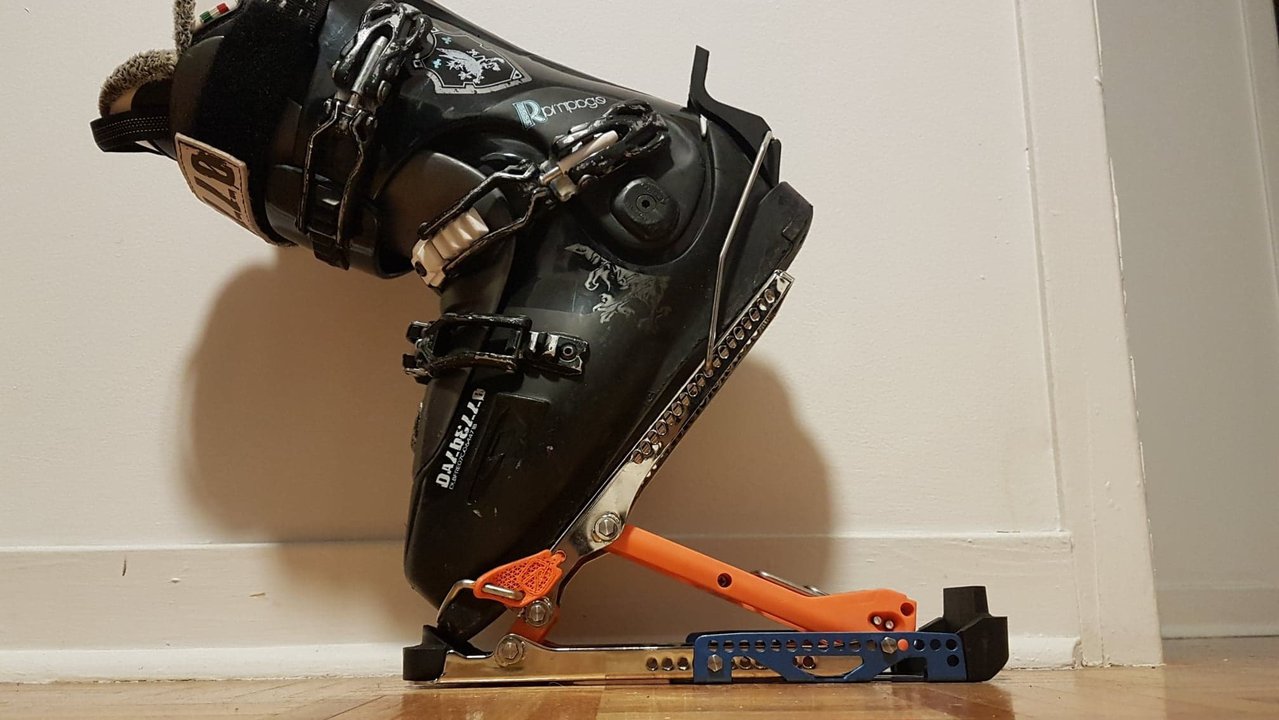The Daymakers have been around for a little while, undergoing a constant improvement process since their launch a couple of years back. Twig got a pair when they first launched but never got around to posting a full review due to a knee injury and a resultant general lack of touring. However, he has now tested them out a fair amount and I recently got a pair with the newest updates so we’ll join forces for a review here. He has interjected a few points on his experience.
For those of you who don’t know, Daymakers are adapters that you snap onto your boots before clicking into your bindings and free up your heel for touring. They are the brainchild of pro skier Giray Dadali and the original Vishnu ski builder Chris Trunek.

Let’s start by addressing things main thing we agreed about. What appealed to both of us the most about Daymakers was the option to use regular boots and bindings. Of course, it’s more comfortable to tour in a boot with proper walking mode, but you can make the Daymakers work with your everyday ski setup + skins. Though Daymakers aren’t a cheap purchase ($359,99 USD), they are an affordable alternative to buying a full new touring kit - skis, bindings and boots which can easily cost $500+ each. You can also then ski with the gear you love and trust the most on your way down which to me is a huge plus as I have faith in my Pivot 14s [Twig: I'm an Attack 16 guy but same story]. There is simply no touring option that gives you a better downhill ride than the Daymaker.
Getting them on and off
One of Twig’s main concerns was the fiddly process of getting them on and off. However, Daymaker did come up with two upgrades since he got his pair. One is the rubber strap keeping the toe bail more stable while clicking the adapters on your boots. The other is an anti-catch T-plate which keeps the heel clamp from moving side to side. [Twig: I did some multi-day tours on the Daymaker which involved regular switching between ski and tour mode and the comparative fiddliness of switching caused an issue keeping up with my friends on pins/frames. The upgrades seem like a great fix]. Both undoubtedly make the process of getting in and out much smoother, but it will never be as easy as on a binding such as the Salomon Guardian to switch back to ski mode without taking your skis off. Caution about frame bindings though, it's common to get snow stuck under the frame while touring and have to chisel it away to click down to ski mode. I've heard stories of athletes skinning to a jump session and airing in tour mode by accident because of snow blocking the latching system. With Daymakers, you will always have to take your skis off to remove the adapters and click back in for ski mode. This is an added step but that also means you know your skis are secured in solid bindings. Generally, the upgrades do make it an easy process when you’re in mellow terrain, but switching them in a sketchy location may be a challenge.
https://www.newschoolers.com/videos/watch/916592/Daymaker-clicking-in-and-out-v2-mp4
Clicking in and out of the adapters
As you can see, pretty easy for my situation. Note I didn’t remove my skins there, just wanted to show that taking these off is pretty smooth. I would expect this to be tougher on a sketchy peak or in heinous weather conditions. Once they’re off and you’re in ski mode, another downside to Daymakers is the added weight to your backpack. A pair weighs 1,380g, so just a bit less than a 1.5L bottle of water so they’re not that heavy, but you obviously want to pack as light as possible to enjoy the ride. I would also imagine that skinning to a jump session, Daymakers are the best setup. You can just leave your adapters in your pack with the rest of your stuff while you hike and hit the jump with your prime ski/binding combo.
Quick note, plan ahead for packing them after the skin up. Do you have a separate pocket for the adapters and your skins? If not, make sure to bring an extra empty bag to keep them isolated from the rest of your pack. This is to keep your other things dry.
The uphill experience, walking motion
Once the adapters are on and you’re clicked in, the touring motion is great. Your binding setup may be heavier than a pin kit, but compared to frames one advantage that Daymaker offers is that you’re not really lifting weight with your heel. Your binding heel piece stays flat so you only lift your boot and drag your ski forward. I found that to be quite comfortable and to make the added weight less noticeable. In theory, the only time you’ll feel the full weight of the heavier setup is when kick turning.

Skinning up Orford, QC
Additionally, Daymaker developed what they call the 4-Bar Tech (patent-pending) to improve on the ergonomics of touring. TLDR, the pressure gets distributed to the ball of your foot versus remaining at your toe like with other touring bindings. It did feel comfortable climbing up.
[Twig: I found the walk motion far more comfortable than any frame binding I’ve tried, more comparable to pins. I found with both Guardians and Dukes that I get sore hips quite quickly, I assume from the placement of the pivot point. But I had no issues even after several hours of touring on Daymakers]. You can read more here.

The riser modes on the Daymakers take a little more getting used to. You can switch them with your poles, but I found it easier at first to just bend down and do it with my hand as the riser pins are thin and need precision [Twig: I found the riser pins pretty stiff to operate, even if I could get a grip with my pole, it would flex my basket rather than lift. So I also got used to doing it with my hand. You can easily flip them back down again though]. After a few tours, I found that the best technique is to flip your pole and push it with your grip. It's more rigid and using the slot where your strap comes out works nicely to pull a riser pin up.
There are two riser angles to choose from, as well as flat mode, so the adapters will adjust to steep terrain when needed and offer more of a range than most alternatives.
[Twig: For me the one functional issue that arose with the Daymakers was the stack height. It’s an absolute non-issue on simple tours, which is, after all, what these are primarily designed for. But I found the Daymaker less comfortable than other touring options in sketchy zones, particularly when traversing. Because of the stack height, I felt I had less stability on steep traverses and actually slid out a couple of times, which was scary. The target user of the Daymaker won’t really ever run into this issue and the adapters do feel torsionally stable in most regular situations, but it seemed worth noting nonetheless].
Concerning the stack height, I agree that it can feel less stable. It is a trade-off though and people will have different opinions depending on their type of riding. I'd rather have that stack height while touring than while skiing like you would with frame bindings [Twig: Agreed, I'd also trade the difficulty in this one rare instance for the ability to ride my regular boots/bindings downhill].
Conclusion (For Now):
Overall, I really liked Daymakers and I expect these to remain my choice of setup for touring at least for the next couple of years and in my mind, they’re the best solution for advanced skiers to get into touring for an affordable price. I recommend them for those who want to feel as comfortable as possible for charging down a mountain, buttering, backcountry jump sessions - you name it - after skinning up. I would caution to be mindful that you need to unclip your skis in order to remove the adapters and switch to ski mode, so maybe not the best option if you’re going to need to change mode somewhere exposed or steep, or if you traverse a lot. [Twig: I also highly recommend these for general touring use. They will continue to be my go-to touring setup this winter as I’ve yet to find a better compromise.]
_
To see our reviews before anyone else, download the Newschoolers App: iPhone- Android
Find out what I'm reviewing in real time: @zclipdave


Comments